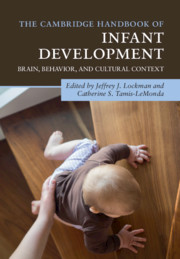Book contents
- The Cambridge Handbook of Infant Development
- The Cambridge Handbook of Infant Development
- Copyright page
- Dedication
- Contents
- Illustrations
- Contributors
- Preface
- Part I Foundations
- Part II Perceptual Development
- Part III Cognitive Development
- Part IV Action
- Part V Language
- Part VI Emotional and Social Development
- 25 Infant Attachment (to Mother and Father) and Its Place in Human Development
- 26 Infant Emotion Development and Temperament
- 27 Infant Emotional Development
- 28 Understanding and Evaluating the Moral World in Infancy
- 29 Cross-Cultural Perspectives on Parent–Infant Interactions
- Index
- References
29 - Cross-Cultural Perspectives on Parent–Infant Interactions
from Part VI - Emotional and Social Development
Published online by Cambridge University Press: 26 September 2020
- The Cambridge Handbook of Infant Development
- The Cambridge Handbook of Infant Development
- Copyright page
- Dedication
- Contents
- Illustrations
- Contributors
- Preface
- Part I Foundations
- Part II Perceptual Development
- Part III Cognitive Development
- Part IV Action
- Part V Language
- Part VI Emotional and Social Development
- 25 Infant Attachment (to Mother and Father) and Its Place in Human Development
- 26 Infant Emotion Development and Temperament
- 27 Infant Emotional Development
- 28 Understanding and Evaluating the Moral World in Infancy
- 29 Cross-Cultural Perspectives on Parent–Infant Interactions
- Index
- References
Summary
Each day more than three-quarters of a million adults around the world experience the joys and heartaches just as they do the rewards and fears of becoming parents to a newborn infant. Each infant is an individual, of course, as is each parent and each parent–infant dyad. Yet, parents and infants around the globe share a large number of commonalities. No matter their homeland, parents have the same responsibilities to guide their infants’ survival and success in life, and their infants have the same biological needs and must meet and succeed at the same developmental tasks and challenges. Although infancy encompasses only a small fraction of the life span, it is a period that parents the world over attend to and invest in. Parenting an infant is a 168-hour-a-week job. With good reason: Parenting responsibilities are arguably the greatest during the time of their child’s infancy because human infants are totally dependent on caregiving and their ability to cope alone is minimal.
Keywords
- Type
- Chapter
- Information
- The Cambridge Handbook of Infant DevelopmentBrain, Behavior, and Cultural Context, pp. 805 - 832Publisher: Cambridge University PressPrint publication year: 2020
References
- 3
- Cited by



